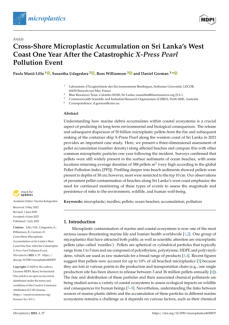

Environmental studies 2025





Click on the
octopus to return to
the top of the page

Author: Rasik Akhtar Apon
This review discusses the impact of ship pollution on
ocean animals, including the Florida Manatee, Seabirds,
Hawksbill Turtle, and Beluga Whales. Ships transport over
80% of the world's commodities and transfer 3-5 billion
tons of ballast water annually. Pollution sources include oil
spills, chemical discharges, garbage, sewage, engine
emissions, and anti-fouling paint. It shows that noise
pollution from ships and other marine structures can lead
to auditory masking, cochlear damage, behavioral
changes, disrupted metabolisms, reduced population
recruitment, and ultimately harm marine ecosystems


01 - Effects of Ship pollution in Marine Life
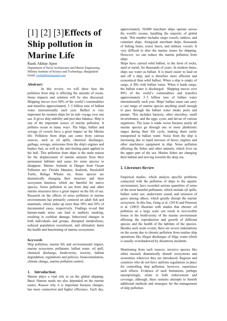



02 - The Role of the MEMAC in Protecting the Marine Environment
of the Persian Gulf
Authors: Fatemeh Arjmand, Ali Mashdi
The Persian Gulf marine pollution poses a significant
global challenge, with oil spills causing irreparable
damage. International maritime law and regional
organizations, such as the Regional Cooperation Council
for Combating Marine Pollution (MEMAC), play crucial
roles in addressing these emergencies. However,
challenges remain, including continous oil spills and
inadequate financial and technological resources.
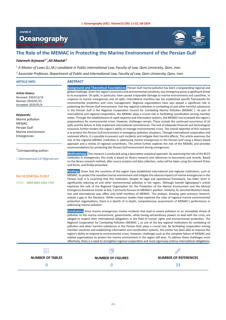



03 - Surfacing and diving behavior associated with thermal
physiology in oceanic habitats of skipjack tuna ( Katsuwonus
pelamis) in the western north Pacific Ocean)
Authors: Yoshinori Aoki, Takashi Kitagawa, and Hidetada
Kiyofuji
This study examines how thermal physiology influences
skipjack tuna's vertical behavior during northward
migration in the western North Pacific. Using archival tag
data, the researchers measured surfacing and diving
behavior and estimated the whole-body heat transfer
coefficient during cooling and warming phases. Results
showed that skipjack tuna were more widespread in
southern mixed layer areas and restricted to surface areas
in strong thermocline areas, and minor to no differences
in heat transfer coefficient values between cooling and
warming phases in southern regions.
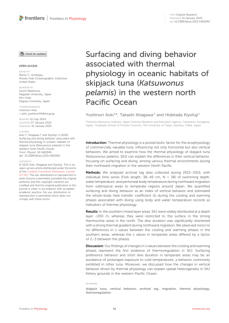


04 - How Marine Plastic Pollution Education Develops Secondary
School Students’ Sustainability Competences
Authors: Viktoria Smenes, and Hilde Ervik
This study examines Norwegian secondary school
students' knowledge and attitudes towards marine plastic
pollution. Results show that 51.4% of respondents have
adequate knowledge about protecting biodiversity, 29.7%
understand microplastics as threats, and 35.1% believe
their actions will make a difference. However, the study
suggests that international cooperation on sustainable
development is needed. The findings provide a
foundation for marine plastic pollution education.
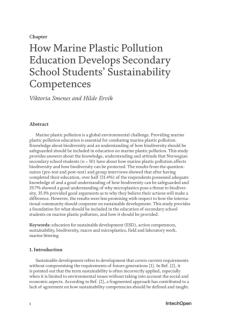



05 - Research on High-Performance Biosensors for Effective Marine
Pollution Monitoring
Authors: Yanhan Xia
This article discusses the importance of biosensors in
monitoring marine pollution caused by human activities. It
examines their composition, classification, and working
principles, and their detection effects in various aspects of
marine pollution detection. It anticipates the future
development of multi-characteristic sensing platforms for
coastal sensor networks. Finally, it emphasizes the need
for more empirical studies and field tests to evaluate the
performance of marine biosensors.
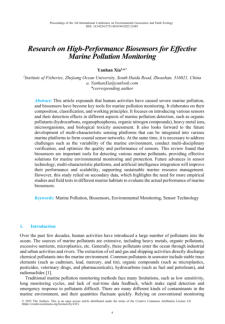


06 - Benthic Feeding and Diet Partitioning in Red Sea Mesopelagic
Fish Resolved Through DNA Metabarcoding and ROV Footage
Authors: Kah Kheng Lim, Carlos Angulo-Preckler,
Christopher A. Hempel, ohammad A. Qurban,
Vincent A. Pieribone, Carlos M. Duarte
This study examines the dietary composition of two
common mesopelagic fish species in the Red Sea: the
lanternfish (Benthosema taxa) and the endemic lightfish
(Vinciguerria mabahiss). Results show V. mabahiss has
higher prey diversity than Benthosema taxa, suggesting a
more generalist feeding strategy. Both species primarily
consume copepods, but V. mabahiss occasionally
consumes gelatinous prey. These mesopelagic fish
contribute to the biological carbon pump, redistributing
organic material through diel vertical migrations.
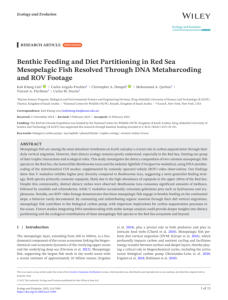



07 - Evaluating Solutions to Marine Plastic Pollution
Authors: Diego Vergara, Javier de la Hoz-M, Edwan
Anderson Ariza-Echeverri, Pablo Fernández-
Arias, and Álvaro Antón-Sancho
Plastic waste pollution in oceans is a major environmental
issue, with millions of tons of polymers floating on the
surface. This pollution negatively impacts marine
ecosystems and wildlife, and can lead to harmful effects
on human health. A growing global commitment to
sustainability is being made, with research focusing on
data-driven models, circular economy innovations, and
microplastics' impact on ecosystems and human health.
Integrating advanced technologies with sustainable
practices is crucial.
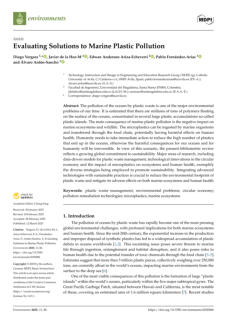


08 - An FMEA Assessment of an HTR-Based Hydrogen Production
Plant
Authors: Lorenzo Damiani, Francesco Novarini, and
Guglielmo Lomonaco
This paper discusses the use of hydrogen as an energy
vector, specifically Steam Methane Reforming (SMR), a
high-temperature chemical reaction between steam and
CH4. It examines a plant using a helium-cooled high-
temperature nuclear reactor (HTR) and its safety and
reliability features. The paper uses Failure Modes and
Effects Analysis (FMEA) to assess hydrogen production
reliability over 20 years, identifying failures and proposing
improvements to improve reliability.
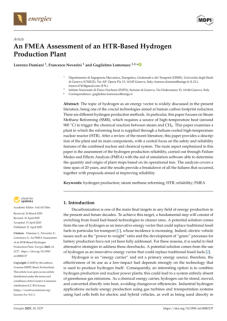



09 - Heavy metal alarm of marine fish consumption surrounding
Qiongzhou Strait, the South China Sea

Authors: Peng Zhang, Zijun Ye, Liping Huang, Xuefeng
Wang, and Wei Zhang
Heavy metal pollution in marine ecosystems is a significant
concern, and monitoring levels is crucial for human
health. This study investigates the bioaccumulation of
eight elements in marine fish in the Qiongzhou Strait,
South China Sea. Zinc is the predominant heavy metal,
with the lowest risk in Pampus argenteus. Uroconger
lepturus has an elevated risk of As bioaccumulation.
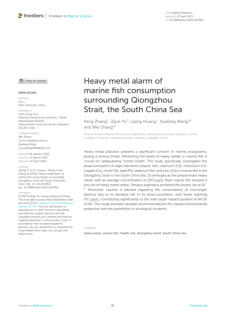



10 - Spatial distribution and risk assessment of heavy metal(loid)s in
sediments and marine organisms in the Yellow River estuary
and its adjacent areas, China
Author: Enkang Wang, Jing Wang, Yonggen Sun, Jinxia
Zhao, Zhiwei Zhang, Guoqiang Xu, Yongqiang
Zhang, and Daolai Zhang
Heavy metals (HMs) are widespread pollutants in marine
ecosystems, mainly derived from natural sources. This
study started in October 2022 determined the extent of
HM in the Yellow River estuary and its surrounding areas
by analyzing the contents of seven HMs in 103 surface
sediments and 82 marine organisms. The results showed
that all other HMs had similar spatial distributions and
were mainly derived from natural sources.
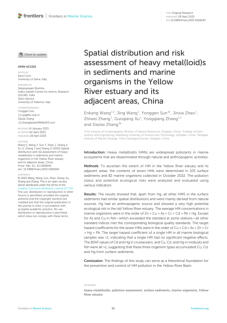


11 - Exposure to plastic debris alters expression of biomineralization,
immune, and stress-related genes in the eastern oyster
(Crassostrea virginica)
Authors: Laura E. Eierman, Jacob Landis
The degradation of marine plastic debris poses a threat to
organisms by fragmenting into micro- and nano-scale
pieces and releasing a complex chemical leachate into the
water. This study examined the holistic threat of plastic
exposure and the synergistic impacts of chemical mixtures.
This study found that both gill and gonadal tissue samples
had altered expression of immune and stress-response
genes in response to plastic exposure.
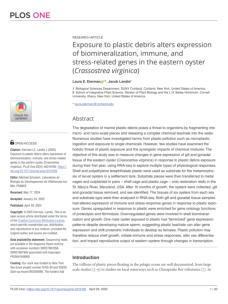



12 - Microplastic pollution in aquatic environments: a meta-analysis
of in inuencing factors and methodological recommendations
Authors: Linus Hartz, Lisa Grabinski, and Samir Salameh
This meta-analysis of over 60 studies across Europe found
that microplastic concentrations correlate with mesh size
in marine environments but not freshwater environments,
suggesting primary microplastics in freshwater. It
highlights that factors influencing microplastic distribution
include sampling latitude, proximity to wastewater
treatment plants, population density, mesh size, distance
to coastlines, seasonal variations, and wind speeds. It
recommends specific standardized methodologies to
enhance data comparability and accuracy.
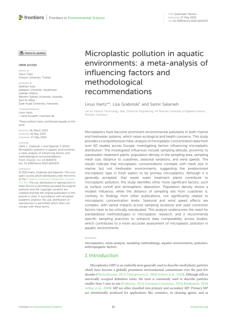



13 - Examining marine pollution governance from the perspective
of international investment law: theoretical connection,
development trends, and China’s experience
Authors: Xue Liu, and Zhanyang Yu
This study examines ocean pollution governance through
international investment law, focusing on environmental
clauses and China's marine environmental laws. Findings
suggest a shift towards "greening" rules, emphasizing
ecological provisions. However, earlier treaties often
lacked comprehensive clauses, restricting regulatory
capacities. Strengthening multilateral cooperation and
promoting marine environmental regulations can mitigate
the negative impacts of investor-state dispute settlement
(ISDS).
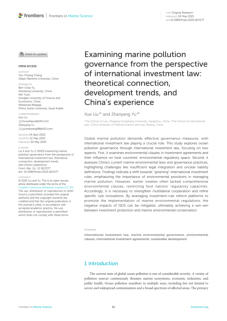



14 - Immediate and short-term effects of pile-driving on Hector’s
dolphin in Lyttelton Harbour, Aotearoa New Zealand
Authors: Deanna M. Clement, Heloise Pavanato, Crystal
Lenky, and Matthew K. Pine
Aotearoa New Zealand's Lyttelton Port Company is the
first port to monitor pile-driving noise effects on local
Hector's dolphins. The dolphins' responses were assessed
using autonomous underwater recorders. Results showed
that as sound exposure increased, dolphin detections
declined, with immediate declines at sites less than 1km
away. After piling ceased, dolphins returned to inner
harbor waters, but a longer-term decline occurred during
the 2019 construction period. Mitigation measures were
successful, but additional measures are needed for future
port infrastructure developments.
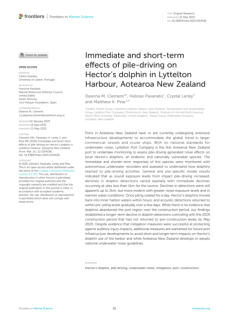



15 - International Legal Systems in Tackling the Marine Plastic
Pollution: A Critical Analysis of UNCLOS and MARPOL
Authors: Yen-Chiang Chang, and Muhammad Saqib
Marine plastic pollution is a pressing environmental issue
affecting marine ecosystems and human health. Despite
international agreements like UNCLOS and MARPOL,
existing laws often fail to address the problem. This study
examines UNCLOS and MARPOL's responses to land-
based and ship-based MPP, highlighting gaps in their
frameworks. It proposes practical proposals to refine
international laws, strengthen enforcement, and
encourage collective action, including a circular economy
model, legal infrastructure, and a single global response.
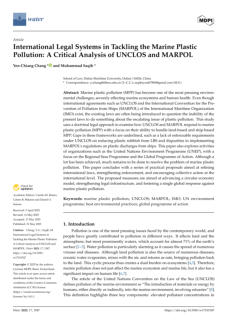



16 - Applications of Fluorescence Technology for Rapid
Identification of Marine Plastic Pollution
Authors: Haoyu Zhang, Yanjun Li, Lixin Zhu, Xindi Song,
Changbin Ren, Buyu Guo, and Yanzhen Gu
The increasing global plastic production is causing marine
plastic pollution, requiring the development of effective
identification technologies. Fluorescence technology is
evaluated for its potential in rapid plastic identification,
identifying different types of plastics and microplastics. It
also demonstrates the effectiveness of fluorescence
techniques for macroplastic identification, highlighting
changes in fluorescence lifetimes and decay rates in
different weathering environments.
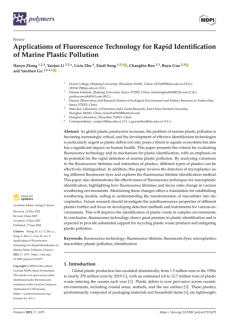


17 - Assessing Plastic Brittleness to Understand Secondary
Microplastic Formation on Beaches: A Hotspot for Weathered
Marine Plastics
Authors: Astrid E. Delorme, Laurent Lebreton, Sarah-
Jeanne Royer, Kimeona Kane, Mael Arhant,
Maelenn Le Gall, and Pierre-Yves Le Gac
This study explores the formation of secondary
microplastics from plastic debris, particularly on Hawaiian
beaches, by investigating the brittleness of polyethylene
and polypropylene particles using a fragmentation test. It
shows a low molecular weight, suggesting advanced
degradation, and provides a large-scale, field-based
quantification of plastic brittleness, underscoring the
severity of coastal and ocean plastic pollution.
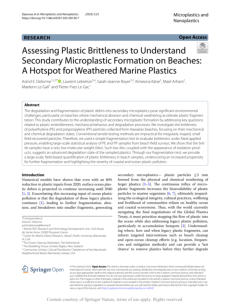



18 - Being there: scientific saturation and technical diving with in
situ instrumentation in an internal surf zone reveal driving
physical dynamics of coral reefs
Authors: James J. Leichter, Stephen R. Wing, M. Dale
Stokes, and Salvatore J. Genovese
Since the 1950s, SCUBA diving has allowed for significant
study of coral reefs, but most diving is limited to shallow,
calm waters for short periods. Over 20 years, researchers
used advanced diving techniques and instruments to
explore deeper areas and challenging conditions. They
found varied reef environments influenced by internal
waves and discovered important links between shallow
and deep ecosystems. Their work emphasized the
importance of continuous monitoring for understanding
reef dynamics, especially amid climate change challenges.
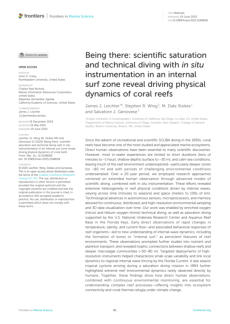


19 - Setting the course: aligning European Union marine pollution
policy ambitions with environmental realities
Authors: Lisa I. Devriese, Thomas J. Verleye, Thomais
Vlachogianni, Thomas Maes, Ben Boteler, Linda
Del Savio, Andy M. Booth, and Kathrin Kopke
Pollution in coastal and marine waters is a global issue
affecting interconnected ecosystems. Effective
management requires a complete governance approach
linking land sources to marine environments. This study
evaluates the state of various pollutants and their
cumulative impacts, comparing them to European Union
environmental goals. A review of EU policies shows that
many targets are unclear or unrealistic, hindering
progress. It offers five recommendations for improving
marine policy, including enhancing regulatory
frameworks, enforcing laws, fostering collaboration, and
integrating health and pollution policies.
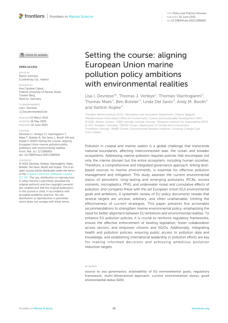



20 - Spatial Dynamics and Ecological Risk Assessment of
Microplastics in Littoral Sediments of the Sea of Marmara, Türkiye
Authors: Esra Billur Balcıoglu Ilhan
Plastic and microplastic pollution has been a significant
threat to the marine environment, particularly in the Sea
of Marmara due to heavy maritime traffic and industrial
discharges. This study assessed microplastics in surface
sediments from the area's coast. The most common
shapes were fibers and fragments, with polyethylene
being the dominant polymer. Pollution levels were
generally classified as moderate to very high, with no
areas showing low pollution. The study highlights the
urgent need for sustainable measures to protect coastal
ecosystems.
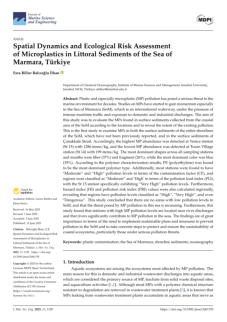



21 - An Experimental Study on the Performance of Proton Exchange
Membrane Fuel Cells with Marine Ion Contamination
Authors: Shian Li, Li Zhang, Gaokui Chen, Ruiyang
Zhang, Aolong Liu, Guogang Yang and
Qiuwan Shen
This study investigates the effects of cation type and
concentration on the performance of Proton Exchange
Membrane Fuel Cells (PEMFCs) in marine salt spray
environments. It shows that cell performance degradation
is observed due to the presence of cations. The study also
compares fuel cells contaminated by NaNO3 and NaCl,
with NaCl causing more severe performance degradation.
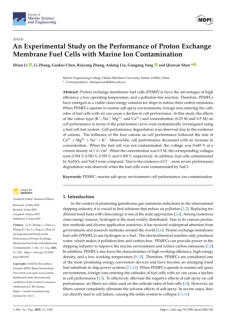



22 - Land Use Change and Mangrove Restoration Modulate Heavy
Metal Accumulation in Tropical Coastal Sediments: A Nearly
Decade-Long Study from Hainan, China
Authors: Tingting Si, Penghua Qiu, Lei Li, Wenqian Zhou,
Chuanzhao Chen, Qidong Shi, Meihuijuan
Jiang, and Yanli Yang
This study analyzed two mangrove reserves in Hainan
Island, China, revealing increasing heavy metal pollution
in the forests. It showed that DZG had higher Cu and Zn
levels but a decline in Cr, As, Cd, and Pb, with Cd showing
the most significant decrease, and also found that
anthropogenic activities are the dominant driver of heavy
metal contamination. The authors suggest stringent
wastewater control near QL, enhanced shipping
regulation, and the establishment of mangrove buffers to
improve ecological status.
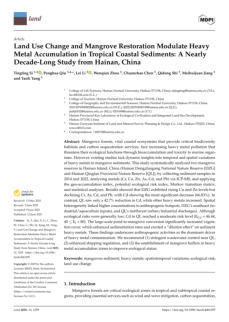



23 - At-Sea Measurement of the Effect of Ship Noise on Mussel
Behaviour
Authors:
Soledad Torres-Guijarro, David Santos-Domínguez, Jose
M. F. Babarro, Laura García Peteiro, and Miguel Gilcoto
Anthropogenic underwater noise negatively impacts
marine species, particularly those sensitive to particle
motion. This study aims to understand the effect of ship
noise on mussel behavior by performing measurements
on a real mussel cultivation raft, using valvometry systems
to monitor shell opening and acoustic fields generated by
traffic, showing cause-and-effect relationships between
ship noise and valve closure events.
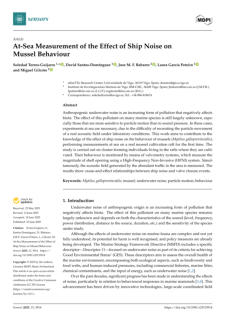



24 - Setting the course: aligning European Union marine pollution
policy ambitions with environmental realities
Authors: Lisa I. Devriese, Thomas J. Verleye, Thomais
Vlachogianni, Thomas Maes, Ben Boteler, Linda
Del Savio, Andy M. Booth, and Kathrin Kopke
This study examines the environmental status of persistent
pollutants and their cumulative effects on marine
environments, comparing them with the European
Union's environmental goals. It suggests five actionable
recommendations to strengthen marine environmental
policy: aligning EU ambitions with environmental realities,
reinforcing regulatory frameworks, promoting
collaboration across sectors, empowering citizens and
national organizations, integrating health and pollution
policies, ensuring public access to pollution data, and
establishing international leadership in pollution efforts.
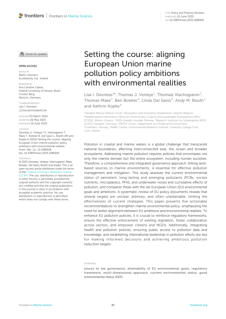



25 - The Simulation of Offshore Radioactive Substances Diffusion
Based on MIKE21: A Case Study of Jiaozhou Bay
Authors: Zhilin Hu, Feng Ye, Ziao Jiao, Junjun Chen, and
Junjun Gong
This study explores radionuclide diffusion patterns in semi-
enclosed bays, focusing on threats to marine ecosystem
stability and coastal socioeconomic resilience. Results
show that tidal oscillations and topographic constraints
prolong pollutant retention by 40%, increasing local
concentration peaks and intensifying bioaccumulation
risks in benthic organisms. These findings inform
sustainable marine resource management and provide
actionable metrics for balancing nuclear energy
development with UN Sustainable Development Goals.
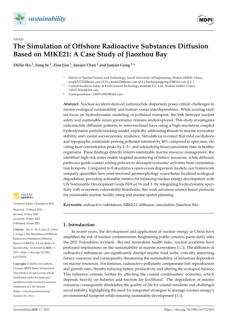

Author: Gudrun Obersteiner, Gabor Bordos, Sabine Lenz,
Marcel Liedermann, Johannes Mayerhofer,
Reinhold Ottner, Sebastian Pessenlehner, Maja
Petrovic, and Dejan Ubavin
Since the launch of the Sustainable Development Goals,
there is increasing concern over riverine microplastics,
especially for reducing marine pollution. This study tested
three monitoring methods at seven sites along the
Danube and Tisza Rivers to evaluate their effectiveness.
Net sampling and pressurized fractionated filtration are
recommended for determining microplastic concentration
and load. The multi-depth net method is best for larger
particles, while pressurized filtration is better for routine
monitoring of smaller particles.


26 - Assessment of Different Sampling, Sample Preparation and
Analysis Methods Addressing Microplastic Concentration and
Transport in Medium and Large Rivers Based on Research in the
Danube River Basin
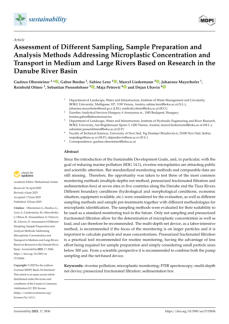



27 - Global Database for Naturally Occurring Radionuclides
Associated with Offshore Oil and Gas Production
Authors: Ziran Wei, Songjie He, Stephanie Sharuga, and
Kanchan Maiti
This study presents a comprehensive dataset on Naturally
Occurring Radionuclides (NORMs) near offshore oil and
gas platforms, focusing on their occurrence, distribution,
and potential environmental impacts. It includes data on
activity levels and exposure from various matrices like
produced water, scales, and sludges, gathered from five
continents over the past 70 years.
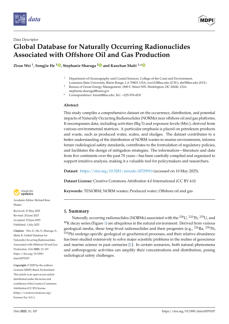



28 - Presence and Potential Effect of Microplastics Associated with
Anthropic Activity in Two Benthic Fishes Serranus scriba and
Lithognathus mormyrus
Authors:
Amanda Cohen-Sanchez, Juan Alejandro Sanz,
Montserrat Compa, Maria Magdalena Quetglas-Llabres,
Maria del Mar Ribas-Taberner, Lorenzo Gil, Silvia Tejada,
Samuel Pinya, and Antoni Sureda
This study examined the impact of microplastics pollution
on two coastal fish species near Mallorca, showing that
areas with higher tourism activity had more plastic
contamination. It identified mainly polyethylene and
polypropylene in water, sediment, and fish tissues. Fish
from more polluted areas exhibited increased levels of
antioxidant, detoxification, and inflammation biomarkers,
indicating an adaptive response to microplastic exposure.
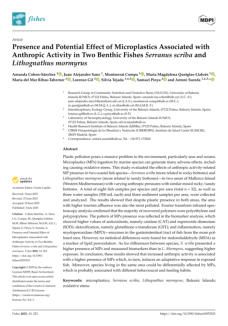


29 - Improving YOLOv11 for marine water quality monitoring and
pollution source identification
Author: Fang Wang
Marine pollution is a significant environmental issue,
affecting ecosystems and human health. The You Only
Look Once (YOLO) series has been used for monitoring,
but challenges like irregular shapes and interference limit
accuracy. An improved YOLOv11 model integrates
Deformable Convolutional Networks, Marine Fusion Loss,
Multi-scale Feature Fusion, and instance segmentation.
Experiments show the improved model outperforms
advanced methods, achieving an average accuracy of
90.2% and an inference speed of 3.5ms.
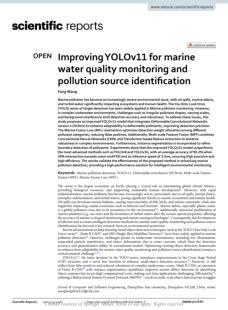



30 - Marine pollution in India: Status and future perspectives
Author: Sandhya Leeda D’Souza
India is a major global contributor to marine pollution,
resulting from waste, sewage, industrial pollutants, and
fishing nets. This review assesses pollution status,
mitigation measures, and effects on biota and human
health. Although control is not complete, effective
implementation could contribute to marine ecosystem
sustainability.
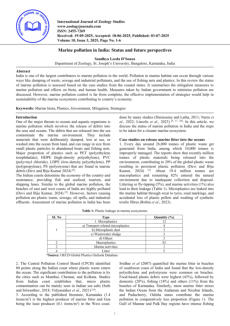



31 - Isolation and Characterization of a Crude Oil-Tolerant Obligate
Halophilic Bacterium from the Great Salt Lake of the United
States of America
Authors: Jonathan Oakes, Johurimam Noah Kuddus,
Easton Downs, Clark Oakey, Kristina Davis, Laith
Mohammad, Kiara Whitely, Carl E. Hjelmen and
Ruhul Kuddus
A bacterial strain from the Great Salt Lake, Salinivibrio
costicola, was tested for its ability to degrade crude oil.
The strain is motile, catalase- and lipase-positive, a
facultative anaerobe, and an obligate halophile. It forms a
biofilm but is nonpathogenic and sensitive to antibiotics.
The strain survived on desiccated agar media but failed to
reduce recoverable petroleum hydrocarbons from crude
oil. These recalcitrant halophiles could be considered for
genetic manipulation for bioremediation.
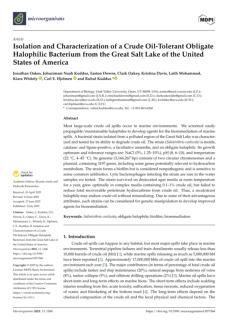



32 - Cross-Shore Microplastic Accumulation on Sri Lanka’s West
Coast One Year After the Catastrophic X-Press Pearl Pollution
Event
Authors: Paula Masiá Lillo, Susantha Udagedara, Ross
Williamson, and Daniel Gorman
The release of 50 billion microplastic pellets from the
sinking of the container ship X-Press Pearl along Sri Lanka's
western coast in 2021 serves as a case study in
understanding marine debris accumulation in coastal
ecosystems. Surveys found pellets were still present in
surface sediments, with some locations having average
densities of 588 pellets m2. Persistent contamination of
beaches highlights the need for continued monitoring to
assess environmental, wildlife, and human risks.
